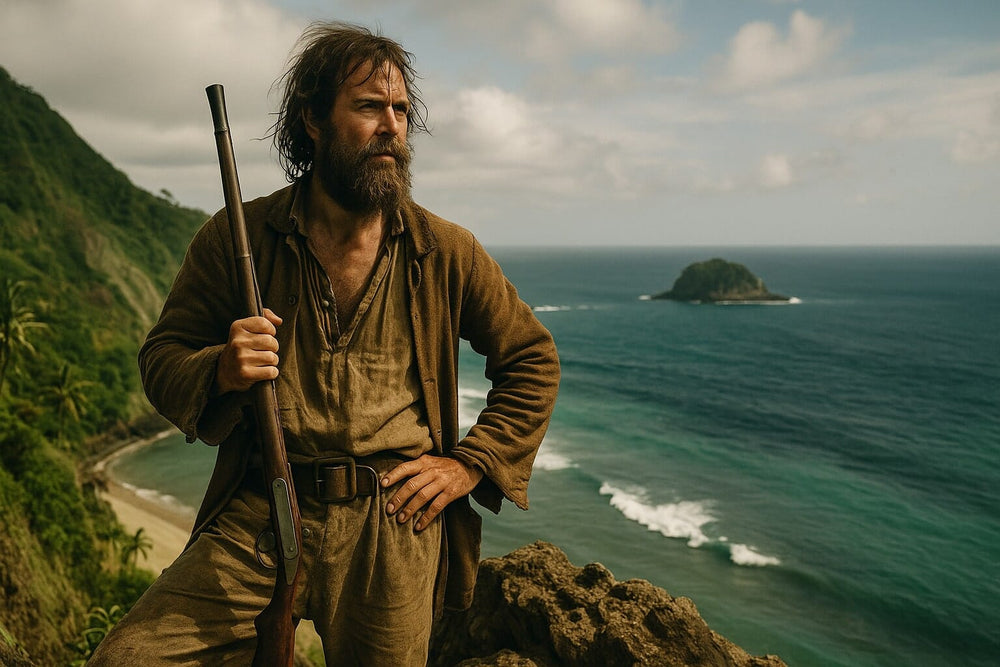
Alexander Selkirk: The Man Who Inspired Robinson Crusoe
Reading Time: about
Some stories are too wild for fiction. A man alone on an island. No rescue in sight. Just the wind, the waves, and whatever will you have left to hold onto. It sounds like a novel—because it became one. But before Robinson Crusoe filled the pages of literary history, there was Alexander Selkirk, flesh and bone.
This is not a tale dreamt up by a writer at his desk. It’s the true story of a Scottish privateer turned castaway, who survived over four years alone on an uninhabited island in the South Pacific. No companions. No script. Just instinct and grit. And before we dive into the long silence of his exile, you might wonder — who was this man before the island claimed him?
Selkirk at a Glance

Statue of Alexander Selkirk at the site of his original house on Main Street, Lower Largo, Fife, Scotland. 23 September 2009. Author Sylvia Stanley
- Name: Alexander Selkirk (sometimes Selcraig)
- Born: 1676, Lower Largo, Scotland
- Died: 13 December 1721, at sea
- Occupation: Sailor, privateer, reluctant legend
- Legacy in print:
- The Original Robinson Crusoe by Henry Cadwallader Adams
- Alexander Selkirk: The Real Robinson Crusoe by Amanda Mitchison
- The Man Who Was Robinson Crusoe by Richard Wilson
- …and more
- On screen:
- Selkirk, the Real Robinson Crusoe by Walter Tournier
Born to Be Cast Away
Before he was a castaway, Alexander Selkirk was already drifting beyond the reach of rules. He was born in the small fishing village of Lower Largo, Scotland, the seventh son of a shoemaker and a tanner — and from the start, he was more wild tide than still water. He fought with his brothers, clashed with the church, and once caused such a ruckus during service that the elders dragged his name before the kirk-session. He didn’t show up. He had already vanished.
At just 19, Selkirk had left behind the cold stone walls of Scotland and joined a privateering voyage to South America. Somewhere along the way, he shed his birth name — Selcraig — and became Selkirk, a reinvention forged in salt air and cannon smoke.
By 1703, his course collided with that of William Dampier, the infamous explorer-pirate. Dampier captained the St George under British commission, skimming the edge of legality. A privateer if the crown said so. A pirate to everyone else. Selkirk, ever drawn to the lawless edge of the world, signed on with the companion ship — the Cinque Ports — under the command of a less-seasoned and far less popular man: Captain Thomas Stradling.

Portrait of William Dampier by Thomas Murray (1663–1734)
Their voyage was part of a shadow war unfolding in the South Pacific, as English ships hunted French and Spanish vessels across oceans. Some historians have called it the first true world war — a tangle of empire, gold, and gunpowder. The Cinque Ports was a hulking sixteen-gun ship built for this fight, and in 1704, it found one. The crew engaged a French ship, the St Joseph, suffering heavy losses before the enemy slipped away to raise the alarm.
Then, the tides shifted. Two months later, Captain Stradling broke ranks with Dampier, hoping to carve out his own glory. But command didn’t suit him. He ruled poorly, inspired little, and among his crew, one voice grew loud with defiance — Alexander Selkirk. He had no patience for incompetence, and soon, a single decision from Stradling would push Selkirk to an act of reckless resolve… one that would leave him marooned and alone.
Mutiny in His Blood, Exile in His Bones
By September 1704, the Cinque Ports was a ship in slow collapse — rot in the hull, fever below deck, tempers flaring above. The men were sick, hungry, and tired of Captain Stradling’s reckless commands. Hope came in sight of land — a volcanic speck in the endless blue: Más a Tierra, part of the Juan Fernández archipelago, off the coast of Chile. 🌴

Robinson Crusoe Island, late 19th–early 20th century. In the bay: the cruiser Esmeralda. Photo by Frances & Frank G. Carpenter
The crew came ashore for food, fresh water, and repairs. But when it was time to set sail again, Selkirk made a fateful choice: he refused to reboard. He declared the ship unseaworthy — and perhaps it was. But more than that, Selkirk likely smelled a mutiny in the making. With years at sea under his belt, he thought the others might follow his lead.
They didn’t. No one stood beside him. And Stradling, spiteful and proud, seized the moment to stamp his authority. Selkirk was marooned — abandoned with a musket, a hatchet, a knife, a cooking pot, a Bible, bedding, and a few clothes. No crew. No second chances.
It’s said that as the sails began to shrink on the horizon, Selkirk’s bravado cracked. He begged to be taken back. Stradling refused, savoring the reversal. The man who’d dared question him would now speak only to waves and wild animals.
And so began four years and four months of exile — not born of shipwreck or storm, but of a decision made in defiance… and regret.
Between Survival and Silence: Selkirk’s Long Reckoning with the Island
At first, Alexander Selkirk waited. He wandered the shoreline, Bible in hand, eyes on the horizon, convinced that an English ship would spot his lonely fire — this week, maybe next. But the weeks bled into months, and then into years. Four years and four months, to be exact. And soon, the island was no longer a waypoint. It was a world.
He started on the coast, living off lobsters and small shellfish, but the solitude cut deep. And then came the sound — not rescue, but Mirounga leonina: massive elephant seals, groaning and clashing along the beach during mating season. Up to six meters long and weighing more than a small truck, their noise was relentless. Selkirk fled inland, seeking silence in the trees.

Bull elephant seals fighting for dominance. Photo by Hullwarren
The island had once known men — Spanish sailors had left behind goats, rats, and cats. The goats saved his life. Milk, meat, leather. The rats, not so much. They swarmed his camp at night until he domesticated the cats, which turned out to be his only companions.
Nature provided the rest: wild turnips, berries, dried fruits, even herbs and spices. Selkirk lived better than some sailors at sea. But it wasn’t comfort — it was survival. He built two huts from pepper trees: one for sleeping, one for cooking. When his shoes fell apart, he walked barefoot, toughened his soles on sharp rock and thorn. And when the gunpowder ran out, he hunted wild goats on foot, sprinting through scrub and stone, spear in hand.
His father had been a tanner, and so he remembered: he scraped hides, dried them, and stitched together clothes from goatskin with nails for needles. He made a knife from rusted iron hoops left behind by sailors long gone. Selkirk didn’t just survive — he adapted, rewired, regressed, evolved.
But the island wasn’t done testing him. Once, while chasing a goat through the high cliffs, he slipped and fell. He landed on the animal — a kill by accident — and lay there, stunned, for a full day before he could move again. Another time, salvation came close… and passed him by. Two ships arrived during his exile — both Spanish. He fled to the jungle. Hunted. Hiding under a tree, he watched a sailor urinate just feet from his face. He didn’t breathe.
In this long exile, he found one constant companion: his Bible. Selkirk read it daily. Sang psalms aloud. Prayed — not just for rescue, but for sanity. For memory. For English. “Much closer to God,” he would later say. In solitude, his voice was the only one he had left.

“Selkirk Reading His Bible”, 1834. From The Life and Adventures of Alexander Selkirk
And then, one day — just as the sea had once taken everything — it brought something back.
The Day the Nightmare Ended
On February 2, 1709, fire and smoke curled into the sky from the hills of Más a Tierra. It wasn’t the first time Selkirk had tried to signal a ship. But this time, the sails came closer. And they kept coming. For the first time in 1,474 days, someone answered him.
The ship was English. He saw the flag. He ran. He shouted. He wept. Dressed in tattered goatskin he’d sewn with his own hands, the castaway emerged from the trees, screaming with joy — not just at rescue, but at the sound of his own language spoken by living men.
Fate, ever twisted, added a final flourish: William Dampier was aboard. Not as captain this time, but as pilot of the Duke, under the command of Woodes Rogers. Dampier had once been part of the expedition that left Selkirk behind — now he stood on the deck as the man returned from the dead.
Selkirk wasn’t just a wrecked soul rescued — he became the rescuer. The Duke's crew was short on food, and many were sick with scurvy. But Selkirk knew the island like a second skin. He led them to fresh meat, herbs, fruit, water. He nursed men back to strength. Rogers, half in jest and half in awe, called him “the governor of the island.”

Title page of The Life and Adventures of Alexander Selkirk, the Real Robinson Crusoe (1835). Author unknown.
Rogers would later write of the encounter: “It may be seen that solitude and retirement from the world is not so unbearable a state of life as most men imagine — especially when people are called or thrown into it unavoidably, as this man was.”
Selkirk had survived what should have broken him. And when the world finally came back, he met it not as a victim, but as something stranger — a man remade.
Back from the Dead
Selkirk had been rescued, but he wasn’t done with danger. Home could wait. He joined his rescuers in raiding Spanish ships along the coast of Mexico — the pirate’s blood still ran hot. Within a year, he was captain of his own ship, a man who had gone from castaway to commander in the span of months.

Portrait of Tatler journalist Richard Steele, who helped immortalize Selkirk’s tale. Author unknown.
It wasn’t until 1711richer in story than in coin, though £800 from the rights to his tale was nothing to scoff at. The writer Richard Steele captured his odyssey in print, turning him into a living myth — the man who had lived what fiction barely dared to imagine.
When he made his way north to Lower Largo, his old village in Scotland, his family was stunned. They had buried him in their minds decades earlier. And here he was — sun-blackened, goatskin-hardened, eyes full of distance. A ghost returned from the wild, walking their streets.
He became a local legend. A man who had spoken with no one but God and goats for nearly five years — and lived to tell it. But for Selkirk, fame was never the reward. It was just the echo of an island that would never truly let him go.
A Quiet Death After a Life Too Loud to Forget
He survived starvation, solitude, and silence. But life back among men proved harder to endure. The island had changed him. Or perhaps it had simply revealed who he’d always been. Alexander Selkirk was no diplomat before his exile — and even less of one after. Soon, he found himself in trouble once again, jailed for fighting a ship’s carpenter. Two years behind bars. Another kind of island.

Combat de la Poursuivante contre l'Hercule, 1803, by Louis-Philippe Crépin (1772–1851)
When free, he spent his coin in pubs, telling stories of goats, seals, and psalms to anyone who’d buy him a drink. His fame faded, his fortune vanished. In 1717, restless again, he left his village with a young milkmaid named Sophia Bruce and headed for London. The romance didn’t last. Neither did the peace.
Less than a year later, Selkirk was back at sea, this time as a lieutenant in the Royal Navy. In 1720, he married again — a widowed innkeeper from Plymouth. But this time, it wasn’t life that pulled him away.
On 13 December 1721, Alexander Selkirk died of yellow fever off the coast of West Africa. He was 45 years old. No psalms. No firelight. No last signal from a lonely hill. Just the sea, as always — taking back one of its own.
The Wreck of the Others
As for the men who sailed with him on the Cinque Ports — their story turned darker still. Captain Thomas Stradling’s gamble failed not long after he left Selkirk behind. The ship sprang leaks. Water rushed in. Half the crew drowned off the coast of Colombia.
The survivors, Stradling among them, were captured by the Spanish and dragged to Lima. Tortured. Imprisoned. Only 18 men lived to see freedom again.
Maybe, on that forgotten island, in that decisive moment, Stradling should have listened to the man who refused to sail. The man they called mad — who ended up outliving the ship, the plan, and almost the myth itself.
The Legacy of a Castaway King
Alexander Selkirk’s extraordinary journey left a mark far beyond his island exile — ripples that reached his village and the world beyond.
- In 1885, a speech was delivered, unveiling a bronze statue and plaque in his hometown, honoring the man who lived legend.
- On Más a Tierra island, a bronze plaque marks Selkirk’s Lookout, the very place where his fate was sealed and survival forged.
- The island itself was renamed Robinson Crusoe Island by Chilean President Eduardo Frei Montalva — a twist of irony, since Defoe’s fictional Crusoe roamed the Caribbean, not the South Pacific.
- Nearby, another island, Más Afuera, was renamed Alejandro Selkirk Island, though Selkirk likely never stepped foot there.
- His story has inspired books, films, and countless retellings, making him a permanent figure in the pantheon of adventurers.
Though Selkirk’s life was harsh and grounded in raw reality, his name is forever entwined with fiction. When Daniel Defoe’s Robinson Crusoe sailed into readers’ imaginations, comparisons with Selkirk came swiftly. Defoe’s masterpiece drew from many sources, but the shadow of Selkirk’s ordeal looms large. 🌴
Today, Alexander Selkirk stands known as “the real Robinson Crusoe,” one of history’s most celebrated castaways and adventurers.
This quote from Steele calls to mind the words of Jean-Jacques Rousseau, the Swiss philosopher: “Nature has made man happy and good, but [...] society depraves him and makes him miserable.”
Perhaps the greatest gift — or challenge — is to be cast away with only the bare essentials, stripped of society’s noise and excess. Food for thought. 🤯
Thank you for reading this journey into Selkirk’s extraordinary life. Now, we want to hear from you: if you were marooned like Selkirk, do you think you’d survive? Share your thoughts in the comments below!
📫 Related Blog Posts:
📌 Who is Jim Bridger? - The Great Pioneer and Explorer of his Time
📌 Who is Mike Horn? | One of the Greatest Living Explorers
📌 Who is Aron Ralston? | The Man who Sacrificed his Arm to Save his Life
📌 Who is Laura Dekker? | The Youngest Solo Sailor Around the World at 16
📌 Who is Roald Amundsen? | "The Last of the Vikings" and Polar Explorer
Frequently Asked Questions about Alexander Selkirk
Who was Alexander Selkirk?
Alexander Selkirk was a Scottish sailor and privateer best known for surviving over four years alone on an uninhabited island in the South Pacific. His story inspired Daniel Defoe’s famous novel Robinson Crusoe.
Why was Selkirk marooned on the island?
Selkirk refused to sail on a ship he believed was unseaworthy and requested to be left on Más a Tierra island. His decision was partly driven by disagreements with his captain and concerns for his safety.
How long did Alexander Selkirk survive alone?
He survived alone for four years and four months, relying on his resourcefulness, hunting skills, and limited supplies left by previous sailors.
What did Selkirk eat while stranded?
Selkirk ate wild goats introduced by sailors, seafood like lobsters and shellfish, wild fruits, and plants such as turnips found on the island.
Did Alexander Selkirk inspire Robinson Crusoe?
Yes, Selkirk’s ordeal was one of several real-life inspirations for Daniel Defoe’s fictional castaway. Although Robinson Crusoe is a work of fiction, Selkirk’s story provided a key basis for the novel’s realism.
What happened to Selkirk after his rescue?
After being rescued, Selkirk returned to piracy briefly, later served in the Royal Navy, and eventually died of yellow fever in 1721 off the coast of West Africa.
Is Más a Tierra island still called that?
No, it was renamed Robinson Crusoe Island in honor of Selkirk’s story and its connection to Defoe’s novel.
2 comments













De unde știți că intre 1713-1715 Selkirk era căpitanul “Greyhound”…?
You miss the years 1713-1715 when Selkirk was captain of the ‘Greyhound’, a slave ship on the triangular route Bristol-Africa-Barbados-Jamaica-Virginia-Bristol.
Leave a comment